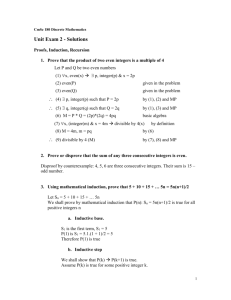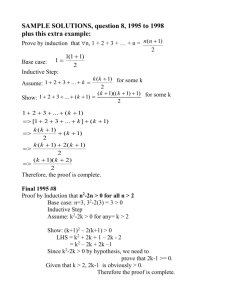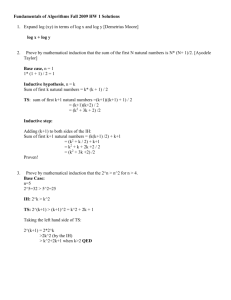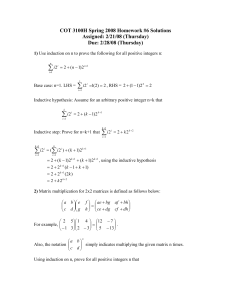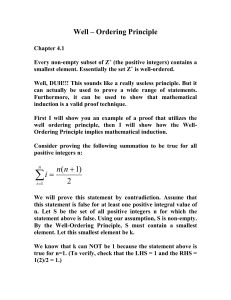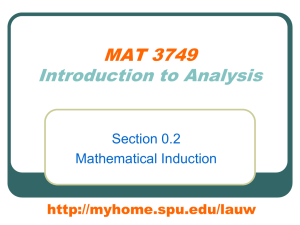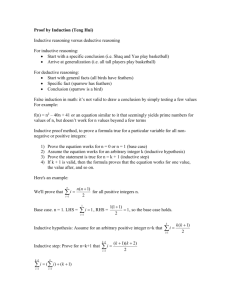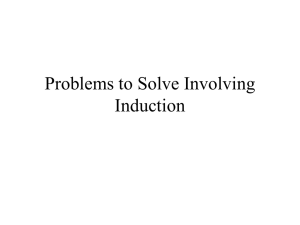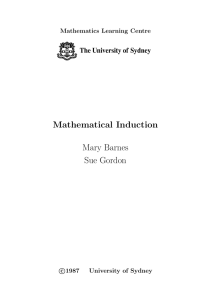IB HL Math Homework #2: Logs, Binomial Theorem and Induction
advertisement
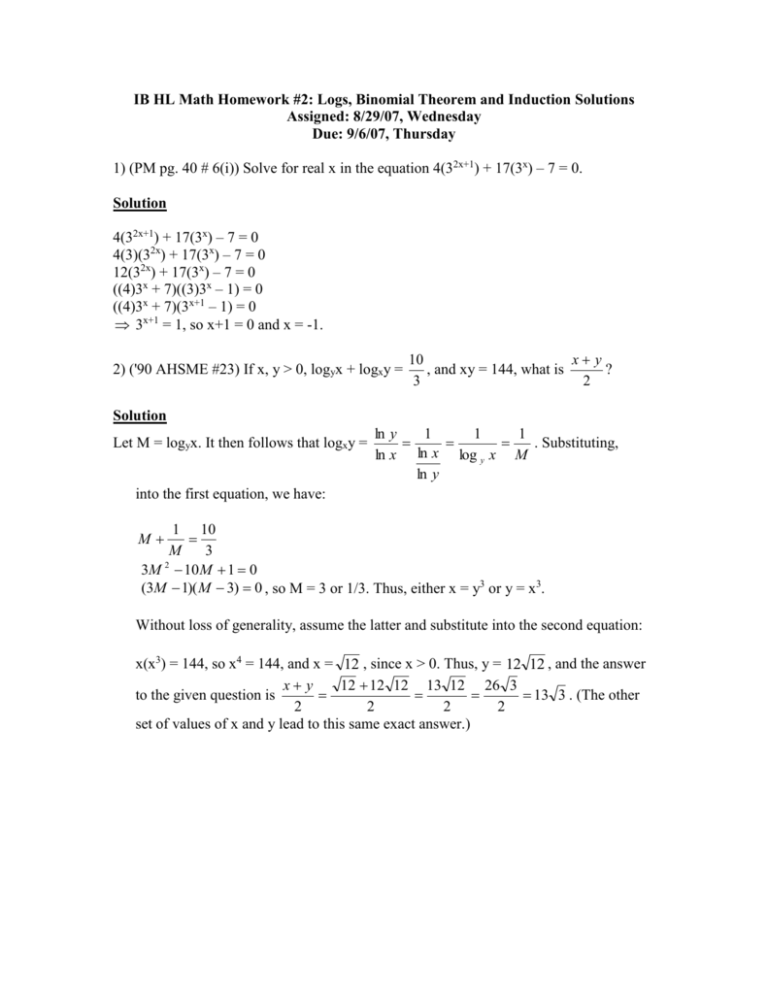
IB HL Math Homework #2: Logs, Binomial Theorem and Induction Solutions
Assigned: 8/29/07, Wednesday
Due: 9/6/07, Thursday
1) (PM pg. 40 # 6(i)) Solve for real x in the equation 4(32x+1) + 17(3x) – 7 = 0.
Solution
4(32x+1) + 17(3x) – 7 = 0
4(3)(32x) + 17(3x) – 7 = 0
12(32x) + 17(3x) – 7 = 0
((4)3x + 7)((3)3x – 1) = 0
((4)3x + 7)(3x+1 – 1) = 0
3x+1 = 1, so x+1 = 0 and x = -1.
2) ('90 AHSME #23) If x, y > 0, logyx + logxy =
10
x y
, and xy = 144, what is
?
3
2
Solution
Let M = logyx. It then follows that logxy =
ln y
1
1
1
. Substituting,
ln x ln x log y x M
ln y
into the first equation, we have:
1 10
M
3
2
3M 10 M 1 0
(3M 1)( M 3) 0 , so M = 3 or 1/3. Thus, either x = y3 or y = x3.
M
Without loss of generality, assume the latter and substitute into the second equation:
x(x3) = 144, so x4 = 144, and x = 12 , since x > 0. Thus, y = 12 12 , and the answer
x y
12 12 12 13 12 26 3
13 3 . (The other
to the given question is
2
2
2
2
set of values of x and y lead to this same exact answer.)
3) ('03 AMC-12 B #17) If log(xy3) = 1 and log(x2y) = 1, what is log(xy)?
Solution
Let a = log x and b = log y.
log(xy3) = 1
log(x2y) = 1
log x + log y3 = 1
log x2 + log y = 1
log x + 3log y = 1
2log x + log y = 1
a + 3b = 1
2a + b = 1
-6a – 3b = -3
---------------5a
= -2, so a = .4 and b = .2
Finally, log(xy) = log x + log y = .4 + .2 = .6.
10
2
4) Find the coefficient of x in the expansion of x 2 .
x
Solution
10
10 10
2 k 2 10k 10 10
2 2
(2)10k x 3k 10
x x ( )
x
x
k 0 k
k 0 k
11
To get the coefficient of x11, we need to find the value of k such that
3k – 10 = 11
3k = 21
k=7
Substituting k = 7 for the general term above, we find the coefficient to x11 in the
10
expansion above is (2) 3 120(8) 960
7
20
3
5) Find the coefficient of x in the expansion of x .
x
Solution
20
20 20
k 3 20k 20 20
3
(3) 20k x 2 k 20
x x ( )
x
x
k 0 k
k 0 k
To get the coefficient of x, we need to find the (integer) value of k such that
2k – 20 = 1
2k = 21
But by this step we can clearly see that no integral k satisfies this equation. This means
that NONE of the terms in the expansion are an x term. Thus, the desired coefficient is 0.
6) Use induction on n to prove that the following summation is true for all non-negative
integers n:
n
(i 2)2
i
(n 1)2 n 1 , for all n 0.
i 0
Solution
(Basis Step) Consider n = 0. In this case,
0
The LHS (i 2)2 i (0 2)2 0 2; and
i 0
the RHS (0 1)2 01 2.
Thus, LHS = RHS, so the Basis Step is proved.
(Induction Hypothesis) Consider n = k. We assume the following is true:
k
i
k 1
(i 2)2 (k 1)2 , for some k 0.
i 0
(Induction Step) Consider n = k + 1. We need to prove
k 1
i
k 11
(k 2)2 k 2 - - - (1).
(i 2)2 (k 1 1)2
i 0
k 1
k
i 0
i 0
(i 2)2 i (i 2)2 i (k 1 2)2 k 1 , by the definition of summation
(k 1)2 k 1 (k 3)2 k 1 , by the Induction Hypothesis
(k 1 k 3)2 k 1 , factoring
(2k 4)2 k 1
2(k 2)2 k 1
(k 2)2 k 2 , because 2(2 k 1 ) 2 k 2
RHS of (1).
Thus, we proved the Induction Step.
By induction, we proved that the summation identity is true for all n 0.
7) Harmonic numbers Hk , k =1, 2, 3, … are defined by
k
1
Hk .
i 1 i
Solution
n
Use mathematical induction on n to prove that
H
i 1
i
(n 1) H n n
for all n 1.
Use induction on n to prove the assertion.
Base case: n=1: LHS = H1 = 1
RHS = (1+1)H1 - 1 = 2(1) - 1 = 1
Thus, the formula is true for n=1.
Inductive Hypothesis: Assume for an arbitrary value of n=k that
k
H
i 1
i
(k 1) H k k
Inductive Step: Prove for n=k+1 that
k 1
H
i 1
k 1
k
H H
i 1
i
i 1
i
i
(k 2) H k 1 (k 1)
H k 1
(k 1) H k k H k 1 , using the inductive hypothesis.
1
(k 1)( H k 1
) k H k 1 , using the definition of harmonic #s.
k 1
1
(k 1) H k 1 (k 1)
k H k 1
k 1
(k 2) H k 1 1 k , combining Hk+1 terms
(k 2) H k 1 (k 1)
This proves the inductive step using the inductive hypothesis. Thus, we can conclude that
for all integers n 1,
n
H
i 1
i
(n 1) H n n .
8) Use induction on n to prove that the following assertion is true for all non-negative
integers n:
2 1
n 1 n
n 1
1 0
n
n
Solution
2 1 2 1
, RHS =
Base case n=1: LHS =
1 0 1 0
1
1 1 1 2 1
.
1 1 1 1 0
Thus, both sides are equal.
Inductive hypothesis: Assume for an arbitrary positive integer n=k that
2 1
k 1 k
k 1
1 0
k
k
Inductive step: Prove for n=k+1 that
2 1
1 0
2 1
1 0
k 1
k 1
(k 1) k 2 k 1
k 2
k
k 1 (k 1) 1 k 1
2 1 2 1
1 0 1 0
k
k 1 k 2 1
, using the inductive hypothesis.
k 1 1 0
k
2(k 1) k (k 1) k (0)
=
2k (k 1) k 0(k 1)
k 2 k 1
, as desired.
=
k
k 1
2 1
n 1 n
.
Thus, for all positive integers n,
n 1
1 0
n
n
9) Using induction on n, prove for all non-negative integers n, 9 | (7n+2 + 52n+1).
Solution
Base case: n=0. 70+2 + 52(0)+1 = 49 + 5 = 54, since 54 = 9(6), we have 9 | 54 and the base
case is true.
Inductive hypothesis: Assume for an arbitrary value of n=k that 9 | (7k+2 + 52k+1).
Equivalently, assume there exists an integer c such that (7k+2 + 52k+1) = 9c.
Inductive step: Prove for n=k+1 that 9 | (7(k+1)+2 + 52(k+1)+1). Equivalently, we must prove
that there exists an integer c' such that (7(k+1)+2 + 52(k+1)+1) = 9c'.
(7(k+1)+2 + 52(k+1)+1) = 7(7k+2) + 52k+3
= 7(7k+2) + (25)52k+1
= 7(7k+2) + (7+18)52k+1
= 7(7k+2) + (7)52k+1+(18)52k+1
= 7(7k+2 + 52k+1)+(2)(9)52k+1
= 7(9c)+(2)(9)52k+1, using the inductive hypothesis.
= 9(7c+(2)52k+1), proving the inductive step, since c and k are
integers.
